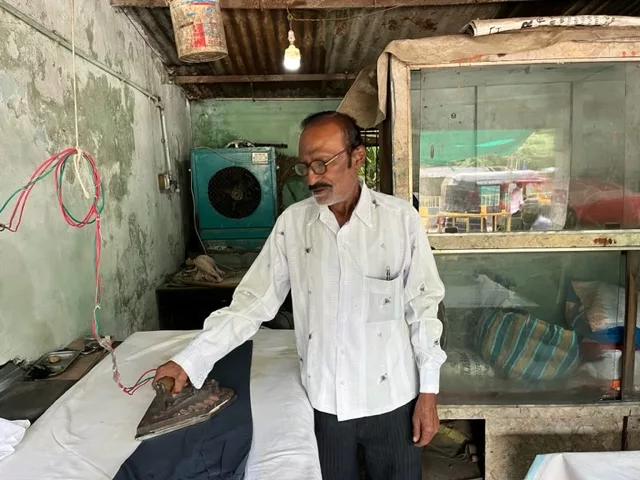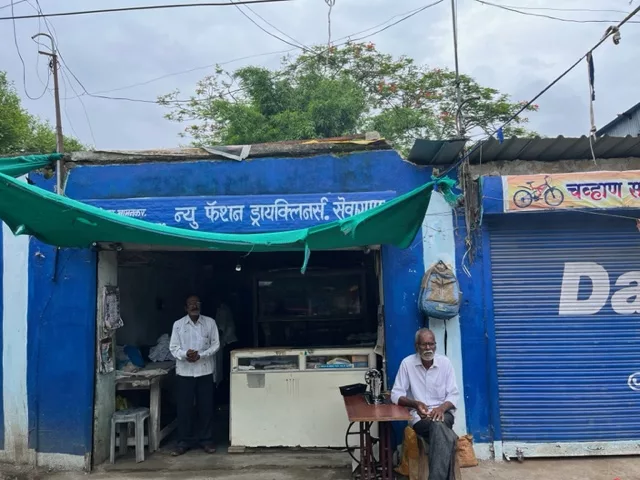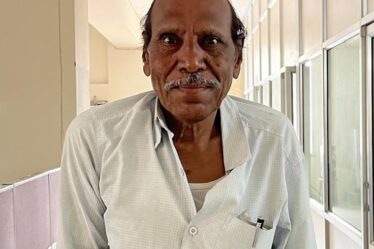
Johny, a somewhat challenging Dhobi, has been an integral part of Sevagram’s fabric for nearly five decades. Since the medical school was established in Sevagram in 1969, Johny has been serving the doctors, nurses, and medical students with his laundry skills.
As the morning dawned, men and women in Sevagram would awaken with thoughts of the milkman, bread supplier, newspaper delivery person, housemaid, and, of course, Johny the Dhobi. Johny held a vital and irreplaceable position in their daily routines. He held a crucial role in their daily lives, earning a special place on that list.
Johny’s true identity went beyond his professional role. Originally named Dnyaneshwar, he hailed from the nearby village of Nandura, just two kilometers away from Sevagram. The story of how Dnyaneshwar became Johny is quite intriguing, and I will share it shortly. He embodied the strong work ethic instilled in him by his father, Moreshwar. Even before MGIMS was established in Sevagram, Moreshwar Khamankar had already built a reputation as a skilled washerman. He worked in the Charakha Sangh in Sevagram in the pre-independance days. It was this family legacy that Johny reluctantly embraced, carrying it forward with him.
“My father, who lived to the ripe age of 95, had the privilege of witnessing Mahatma Gandhi’s serene walks in Sevagram. He observed the likes of Dr. Sushila Nayar, Prabhakarji, Dr. Ramchandra Wardekar, Dr Anant Ranade, and Manimala Choudhary wading through knee-deep mud during the rainy season as they visited villages surrounding Sevagram in Renghi, a cart pulled by bullocks,” Johny fondly recollects.
As a young boy, Johny enrolled in the local primary school in his village. After completing fourth grade, he attended New English High School in Wardha. This meant doing all chores related to washing the clothes in the morning and then walking eight kilometers daily on non-existent roads.
During his tenth grade year, fate threw an unexpected challenge at Johny. On a remote road between Wardha and Sevagram, his bicycle suffered a punctured tire, leaving him unable to reach the school in time for a crucial theory examination. Sadly, this incident became a turning point in Johny’s educational path, and he had to confront the harsh reality of being a school dropout.
Undeterred, Johny started seeking employment opportunities, aiming to support himself and contribute to his family.
Seth Uttamchand and New Fashion Electrical Dry Cleaners
In 1970, fate once again intervened in Johny’s life. Prabhakarji, a dedicated Gandhian from Sevagram Ashram, noticed Johny’s potential and brought him to Hyderabad. For six months, Johny served as Prabhakarji’s trusted assistant, immersing himself in the city’s vibrant atmosphere and absorbing its energy.
While in Hyderabad, a few others from Sevagram, namely Ramana, Sita, and Chinamma (Mausi), also began their own transformative journeys. They later became qualified nurses at Kasturba Hospital. Dr. Satyanarayan Prasad, a local practitioner, generously provided accommodations for them.
Johny’s journey took an unexpected turn. By chance, he came across Seth Uttamchand, a dear friend of Prabhakarji, who owned a renowned establishment called New Fashion Electrical Dry Cleaners. This establishment served a wide range of customers, collecting clothes from 26 different locations in Hyderabad. They skillfully washed, dried, and ironed garments with exceptional expertise. This encounter left a profound impact on Johny, inspiring him deeply.
Years later, when Johny opened his own laundry shop in Sevagram, he paid homage to Seth Uttamchand by naming his shop after his establishment. This reflected the values of excellence and entrepreneurship that had influenced him.
As Johny’s time in Hyderabad came to an end, Prabhakarji saw potential for his future success and proposed securing a promising job and arranging a suitable marriage for him. However, Johny’s father, guided by traditional values and reluctant to let his son move too far from Sevagram, declined the offer. Consequently, Johny’s dreams of relocating to Hyderabad were dashed, and he established his life and connections in and around Sevagram.
Johny’s Journey Takes Unexpected Turns
Johny faced setbacks along the way, but he remained resilient. He briefly worked in the irrigation department and later tried his hand at the Wardha Filaria office. However, due to his father’s traditional beliefs and the importance of maintaining family ties to Sevagram, Johny left both jobs within two weeks of joining.
Although stable employment tempted him, Johny’s sense of familial duty held a stronger sway, influencing his decisions. These short-lived experiences only fueled his determination. They ignited a sense of purpose within him, driving his desire to forge his own path and establish a livelihood through laundry work. Little did he know, these twists and turns would ultimately lead him back to Sevagram, where his dedication and hard work would shape an extraordinary future.
Soaring Popularity: Flocking Customers and Roaming Johny
During his school days, the Khamnakar family worked together tirelessly, washing, drying, and pressing clothes for the hospital and households. Their combined efforts ensured that cleanliness became an art that touched the lives of Sevagram’s students, doctors, and nurses.
Johny took a leap forward in 1972. He acquired a small shop situated near the Mahadev Bhavan in Sevagram, on Wardha-Sevagram road, marking the inception of his own laundry business. During that period, Johny’s shop stood as the first of its kind in the vicinity, with Rajesh Taylor’s shop located nearby.
As time went on, Johny’s popularity soared. People from Sevagram flocked to his shop, and Johny himself would roam around the town, visiting homes and workplaces, leaving behind a trail of fresh laundry and satisfied customers.
The years turned into decades, and Johny continued to serve Sevagram. While not always known for his politeness and courtesy, Johny occasionally found himself engaged in arguments with his customers, usually stemming from misunderstandings. Remarkably, people did not mind these occasional outbursts, despite Johny’s brash tongue. Instead, they acknowledged and appreciated Johny’s skill in providing top-notch ironing services.
There were moments when he appeared visibly irritated, and his tone occasionally conveyed anger, leading to arguments. However, by then the medical students and staff got used to his caustic tongue.
Johny Mera Naam
There is an interesting story behind the transformation of Dnyaneshwar into Johny. In 1970, a widely celebrated crime thriller film Johny Mera Naam, featuring Dev Anand, captivated the entire nation. The movie’s immense popularity caused the name “Johny” to strike a chord with people throughout India.
Whenever medical students visited Dnyaneshwar’s shop, they would rarely find him there. He would often be elsewhere, busy delivering freshly laundered clothes to the hostels. One day, tired of his lengthy name, his mischievous neighbour Rajesh tailor decided to call him Johny. Rajesh would playfully inform the students that Johny was not present at the shop. Unintentionally, this playful response created a connection between the fictional character “Johny” from the film and the washerman they were seeking.
The name deeply resonated with Johny himself, and from that moment onwards, it became an integral part of his identity.
Thus, a combination of popular culture, playful interactions, and linguistic adaptations converged to give rise to the beloved nickname “Johny” for the washerman of Sevagram.
A Changing Landscape: Transformation in the Vicinity
Over time, the vicinity surrounding Johny’s shop underwent a remarkable transformation. New businesses emerged, shaping a small market that catered to the diverse needs of medical students, faculty, health workers, and hospital visitors. Shops such as Gulab Singh’s Sevagram General Store, Jagdish Gutta’s Madras Hotel, Ramu Godse’s Renuka Medical Store, Gulabrao Patil’s Goras, Chintaman’s barber shop and Chavan’s Cycle Shop flourished alongside Johny’s shop.
This vibrant hub now offered more than just laundry services. People could also purchase groceries, indulge in delicious masala dosa, have garments tailored, and even get their bicycles repaired. What was once a modest shop had become a bustling center, providing a wide array of amenities to the community.
The Dhobi Ghat: The Central Hub of Washing Activities
The journey was not devoid of challenges, especially considering that Johny’s father was the sole washerman in Sevagram during those early days. The bustling Dhobi Ghat located near Kasturba Vidya Manidr served as the central hub, where the Khamnakar family would gather the garments for washing. Johny’s father, with the support of his mother, grandmother, wife, and a few helping hands, undertook the arduous task of cleaning the clothes. Bhimabai, his aunt, specialised in laundering cloths from labour rooms and gynaecology wards. The laborious process required their collective efforts and dedication to ensure that each garment was meticulously washed and cared for.
Large drums, filled with water, caustic soda, and soap cakes, served as vessels of transformation as the garments were immersed in their soapy depths. The power of steam worked its magic, ensuring a thorough cleansing of the clothes, which would remain wet until the following day when the process of manual washing began. During that era, washing machines had not yet made their way into the scene, requiring a reliance on the human touch, hard brushes, and meticulous attention to detail.
From Coal to Electric: Embracing Modernization in Ironing
In the 1970s, when Sevagram welcomed aspiring doctors, Johny was the sole washerman dedicated to meeting their laundry needs. Drs. Ingley, Khapre, Harinath, Taori, Kane, Deshkar, Indurkar, Gupta, Narang, Chaturvedi, Trivedi, Jain, Hariharan, Shetty, Belsare and many others relied on him to care for their clothing, establishing a strong bond of trust and dependability.
As Johny reminisces, he recalls the countless medical students who entrusted him with their garments. Dilip Sarnaik, Shyam Babhulkar, the three Sardars (Amarjeet Singh, Avtar Singh, and Hardial Singh), Rajiv Chaudhary, Chandan, Hari Gulhane, Anil Mahalle and Thosar stand out as the trailblazers who began their medical education during those early years. Their names hold a special place in Johny’s mind, symbolizing their significant role in shaping the early days of MGIMS.
In Johny’s fond recollections of those early days, he remembers the substantial workload they faced. They would diligently handle a daily load of 100 garments, earning a modest income of 25 to 50 paise per cloth. A portion of this amount was rightfully shared with the workers who assisted in the laundry process. As time passed and the economic landscape evolved, there was a shift in remuneration. Presently, the rates range from Rs 12 to 15 per shirt or trouser.
In the late 1970s, Johny made the switch from old coal-filled irons to modern electric irons. This transition not only brought convenience and efficiency to his ironing process but also relieved him of the drudgery associated with the older method.
Johny takes great pride in maintaining an impeccable track record throughout his career. Remarkably, not a single garment ever went missing or misplaced under his care. He devised a meticulous system of labelling, organizing, and identifying clothes, utilizing English alphabets to mark each piece with precision. These markings, bearing the initials of their respective owners, stood the test of time. Recently, a former female medical student from Pune, who had long left Sevagram, expressed surprise upon discovering that the mark made by Johny’s pencil on her Khadi apron remained unblemished, unaffected by the passage of time.
With the advent of washing machines in the early 2000s, the laundry services landscape underwent a transformation. Johny witnessed a gradual decline in business as the demand for his meticulous handiwork diminished. Additionally, in earlier years, competition from washermen in Wardha and Sevagram, such as Lonkar and Baliram Dalvi, challenged his monopoly. However, undeterred by these changes, Johny continues to be a constant presence, operating his shop from the same location where it all began in the 1970s.
A Legacy in Tin Shade: Johny’s Shop and Its Timeless Journey
Johny’s journey embodies not just a lifelong dedication to his craft but also the evolution of Sevagram and its medical community. From manual labour to modern machinery, his legacy endures, leaving an unforgettable impression on those who sought his skillful ironing services.

Today, Johny operates his shop in the very same 200-square-foot tin shade where his journey began five decades ago. The interior tells a story of time and wear, with old wooden tables, partly broken cupboards, and cracked glass, giving the shop an unkempt and shabby appearance. The peeling paint on the walls further adds to the worn-out ambiance. Amidst the chaos, an old desert cooler hums softly, providing a bit of respite from the heat.
Perched precariously on a rickety old table, an iron bucket filled with water stands ready for use. Above, a dim tube light casts a gentle glow, illuminating torn calendars adorned with pictures of Hindu deities, adding a touch of spirituality to the surroundings. An aged assistant diligently irons shirts and trousers, while Johny takes on the role of overseer, engaging with customers and tending to logistical matters.
The shop exudes an air of nostalgia, with clothes strewn throughout, waiting to be attended to.
As Johny enters the twilight of his career, he remains steadfast, refusing to be dulled by the passage of time. Like an old coal iron that never loses its heat, he maintains his resilience, vigour, and boldness. Even at the age of 74, he dyes his hair, stands upright, walks briskly, speaks his mind without hesitation, and effortlessly navigates the streets of Sevagram on his cycle.
Like well-tailored fabrics, Johny refuses to fade away, devoid of creases or wrinkles. His spirit remains crisp and steadfast, defying the passage of time.
